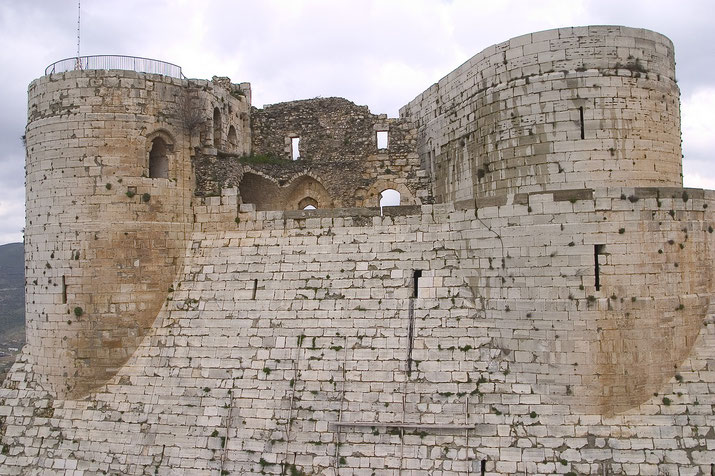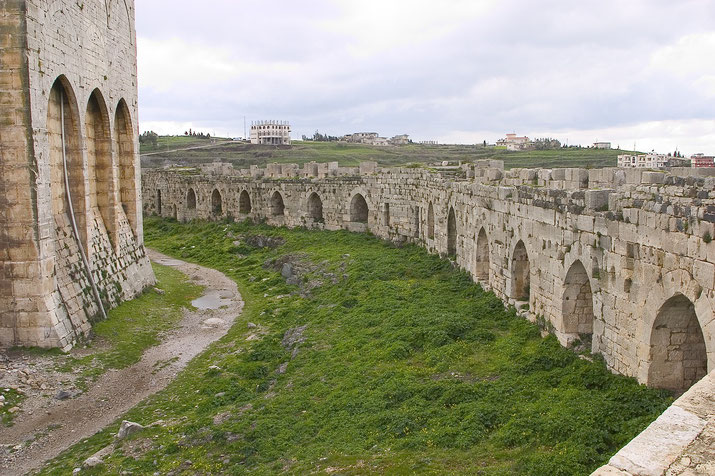Krak des Chevaliers: The greatest medieval castle ever built?

As you approach the towering hilltop fortress of Krak des Chevaliers, it's hard not to be awestruck by its sheer size and impressive fortifications.
This stunning castle, located in Syria, has been standing strong for over 900 years and shows the ingenuity and skill of medieval architects and engineers.
Krak des Chevaliers has been an important stronghold for many rulers throughout its history, from the Emir of Homs to the Knights Hospitaller during the Crusades.
Today, it continues to draw visitors from around the world, who marvel at the beauty and impressive defense mechanisms of this medieval fortress.
What is Krak des Chevaliers?
Krak des Chevaliers is a medieval castle located in the western region of Syria, near the border with Lebanon.
It is considered one of the most well-preserved and impressive examples of Crusader-era fortifications and a significant historical landmark.
The castle was originally a Muslim fortress, built by the Emir of Aleppo in 1031. After the first Crusade in 1099, the site was granted to Raymond IV of Toulouse.
It served as a military outpost of the County of Tripoli, one of the four main Crusader states established in the Levant.
In 1142, the Knights Hospitaller took formal possession of it and began extensive reconstruction and expansion.
Krak des Chevaliers stands on a hill that overlooks a strategic pass that connects the coast with the inland plains of Syria.
The Hospitallers transformed it into a massive concentric castle, with two rings of walls, towers, moats, and a large inner courtyard.
The castle could accommodate up to 2,000 people, including knights, soldiers, servants, and pilgrims.
The complex covers an area of approximately 30,000 square meters, making it one of the largest and most expansive Crusader fortresses.
Ideal defensive position and design
Krak des Chevaliers was strategically positioned on a hilltop overlooking the surrounding countryside, providing a clear vantage point and a significant advantage to its defenders.
The castle's walls were constructed using a combination of local limestone and imported materials, including black basalt.
These materials were carefully selected for their strength and durability, and the walls were built in a layered fashion, with each layer providing additional security.
The castle was surrounded by a deep moat, which made it even more difficult for attackers to breach its walls.
The main entrance was protected by a series of gates and towers, with each gate being designed to slow down and trap advancing armies.
The interior of the castle was divided into several sections, with each section being independently fortified and capable of holding out against attackers.
Krak des Chevaliers was never taken by storm during the Crusades, despite being besieged several times by Muslim armies.
The castle's defenders were able to repel these attacks using a combination of superior military tactics, advanced weaponry, and the castle's formidable fortifications.

How the castle was captured
Baibars, the Mamluk sultan, laid siege to Krak des Chevaliers in 1271, and the siege lasted for several months.
The castle was defended by a garrison of Hospitaller knights and their retainers, with some sources suggesting there was around 2,000 men inside.
The defenders were well-equipped and well-trained, and they had plenty of supplies and provisions to sustain a long siege.
However, they were up against a determined and experienced enemy, and they were eventually forced to surrender.
Baibars employed a number of tactics to wear down the defenders and breach the castle's defenses.
According to Mamluk chronicles, he first tried to starve out the defenders by cutting off their supply lines, but the Hospitallers were able to maintain their stores of food and water.
He then tried to use siege engines to breach the walls, but the defenders were able to repel his attacks.
Baibars also attempted to undermine the castle's walls by digging tunnels beneath them, but the defenders were able to detect and block these attempts.

During the siege, the defenders received a letter from the Grand Master of the Knights Hospitaller in Tripoli, granting them permission to surrender on April 8, 1271.
The letter assured the defenders that they would not lose any honour, or be punished, for surrendering to the attackers.
Seeing little hope of success, the remaining knights agreed to surrender and handed the castle over to the attackers.
However, it turned out that the letter was a forgery, written at the command of Baibars himself.
However, after the garrison capitulated, the Sultan spared the lives of the Crusaders anyway.
As a result, Krak des Chevaliers suffered minimal structural damage after the surrender.
Later history
After the Crusades, Krak des Chevaliers passed through the hands of various rulers and was used for various purposes, including as a prison and a military barracks.
The castle remained sporadically in use until the 19th century, when it was abandoned and partly damaged by earthquakes.
In the 20th century, it was restored and opened to visitors. In 2006 it was designated as a UNESCO World Heritage Site.
In 2013 and 2014 during the Syrian Civil War, the castle sustained damage due to shelling and occupation by armed groups, prompting international concern for its preservation.
Krak des Chevaliers is a remarkable example of medieval military architecture, combining elements of European and Islamic styles.
It is also an example of the history and culture of the Crusades, a period of conflict and exchange between Christians and Muslims in the Middle East.
What do you need help with?
Download ready-to-use digital learning resources
Copyright © History Skills 2014-2025.
Contact via email
With the exception of links to external sites, some historical sources and extracts from specific publications, all content on this website is copyrighted by History Skills. This content may not be copied, republished or redistributed without written permission from the website creator. Please use the Contact page to obtain relevant permission.





